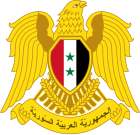Syrian Muslim Brotherhood الإخوان المسلمون في سوريا | |
|---|---|
 | |
| Leader | Mohammad Walid[1] |
| Deputy leader | Mohammad Farouk Tayfour[2] |
| Head of the Shura Council | Mohammad Hatem al-Tabshi[2] |
| Founders | Mustafa al-Siba'i Muhammad al-Mubarak al-Tayyib |
| Founded | 1945 |
| Banned | 1963[3] |
| Headquarters | Damascus (Historical) Idlib (After the Rebels victory in Idlib)[4] |
| Ideology | Pan-Islamism Syrian nationalism Sunni Islamism Neo-Sufism (some elements)[5] Salafism (some elements)[6][7] Social conservatism Religious conservatism Anti-communism Anti-Assad[8] |
| Political position | Right-wing to far-right |
| National affiliation | Syrian National Council National Coalition for Syrian Revolutionary and Opposition Forces[9] |
| International affiliation | Muslim Brotherhood |
| Party flag | |
 | |
| Website | |
| http://www.ikhwansyria.com | |
 |
|---|
|
|
The Muslim Brotherhood in Syria (Arabic: الإخوان المسلمون في سوريا, romanized: al-Ikhwān al-Muslimūn fī Sūrīya)[10] is a Syrian branch of the Sunni Islamist Muslim Brotherhood organization. Its objective is the transformation of Syria into an Islamic state governed by Sharia law through a gradual legal and political process.[10]
The party strongly opposes Pan-Arabism, capitalism, communism, liberalism, and secularism in Syria. Founded at the end of World War II, the Muslim Brotherhood of Syria was seen as one of several important political parties in the 1950s. When Syria unified with Egypt to form the United Arab Republic, the disbanding of the Muslim Brotherhood as a political party was a condition of union, one complicated by Gamal Abdel Nasser's conflict in Egypt with the Egyptian Muslim Brotherhood. The Syrian Muslim Brotherhood was banned by the government of the Syrian Arab Republic starting after the 1963 coup by the secularist, pan-Arabist Ba'ath Party.[11] The Muslim Brotherhood played a major role in dissent against the secular Ba'ath Party during the period 1976–1982,[12] and membership in the Brotherhood in Syria became a capital offence in 1980.[13][7]
Following the Hama uprising of 1982 in the wake of the wider Islamist insurgency in Syria (1979–1982), when thousands of armed insurgents and civilians were killed by the military[14] the Brotherhood was effectively broken as an active political force inside Syria.
The Muslim Brotherhood in exile was among the 250 signatories of the Damascus Declaration of 2005, a statement of unity by Syrian opposition including the Arab nationalist National Democratic Rally, the Kurdish Democratic Alliance, the Committees of Civil Society, the Kurdish Democratic Front, and the Movement of the Future, and calling for "peaceful, gradual," reform "founded on accord, and based on dialogue and recognition of the other".[15]
The Muslim Brotherhood was considered the main opposition group in Syria to the government on the eve of the 2011 uprising, but failed to make a significant mark on the protests against the government.[4][16][17] The Syrian uprising's core population of protesters came from a younger generation which had come of age in a Syria without significant Muslim Brotherhood presence.[18] However, among the expatriated opposition, the Syrian Muslim Brotherhood has come to be seen by some as the "dominant group"[8] or "dominant force"[19] in the opposition during the Syrian civil war as of spring 2012.[8]
- ^ محمد حكمت وليد. Al-Jazeera (in Arabic). 9 November 2014.
- ^ a b "The Muslim Brotherhood in Syria". Carnegie Middle East Center. Retrieved 29 July 2012.
- ^ Banned after the coup that brought the Secular Syrian Ba'ath Party to power, but remained active in Syria
- ^ a b Conduit, Dara (2019). The Muslim Brotherhood in Syria by Dara Conduit. doi:10.1017/9781108758321. hdl:11343/297515. ISBN 9781108758321. S2CID 201528149. Retrieved 25 July 2019.
{{cite book}}:|website=ignored (help) - ^ R. Halverson, Jeffrey (2010). Theology and Creed in Sunni Islam. New York: Palgrave Macmillan. pp. 62, 65. ISBN 978-0-230-10279-8.
Neo-Sufism assumed the basis of a secondary Athari tendency that we find in the thought of Hasan al-Banna and the Muslim Brotherhood... Neo-Sufism... was a major influence on the thought of Hasan al-Banna and the development of the Muslim Brotherhood..
- ^ Sageman, Marc (2004). "Chapter 1: The Origins of the Jihad". UNDERSTANDING TERROR NETWORKS. Philadelphia: University of Pennsylvania Press. p. 7. ISBN 0-8122-3808-7.
- ^ a b S. Moussalli, Ahmad (1999). Historical Dictionary of Islamic Fundamentalist Movements in the Arab World, Iran and Turkey. Folkestone, Kent: The Scarecrow Press. p. 259. ISBN 0-8108-3609-2.
AL-SALAFIYYA. .. In Damascus, many Jordanian students were influenced by the Muslim Brotherhood's Shaykh Mustapha al-Siba'i and 'Isam al-'Attar, both with a long history in al-Salafiyya.
- ^ a b c Sly, Liz (12 May 2012). "Syria's Muslim Brotherhood is gaining influence over anti-Assad revolt". Washington Post. ISSN 0190-8286. Retrieved 5 January 2023.
- ^ "More Divisions Among the Syrian Opposition". Stratfor. 27 February 2012. Retrieved 4 January 2014.
- ^ a b Teitelbaum, Joshua (Spring 2011). "The Muslim Brotherhood in Syria, 1945—1958: Founding, Social Origins, Ideology". The Middle East Journal. 65 (2): 213–233. doi:10.3751/65.2.12. JSTOR 23012146. S2CID 143746726. Retrieved 15 April 2021.
- ^ Wright, Robin, Dreams and Shadows : the Future of the Middle East, Penguin Press, 2008, p.241. ISBN 1594201110.
- ^ Middle East Watch. Syria Unmasked: The Suppression of Human Rights by the Assad Regime. New Haven: Yale UP, 1991
- ^ Wright, Dreams and Shadows, 2008, p.248
- ^ Tore Kjeilen (20 September 2000). "Looklex encyclopedia". Lexicorient.com. Archived from the original on 13 April 2014. Retrieved 25 August 2012.
- ^ "النداء – موقع إعلان دمشق". Annidaa-sy.org. Archived from the original on 5 December 2013. Retrieved 18 December 2013.
- ^ Rothkopf, David. "How the Muslim Brotherhood Hijacked Syria's Revolution". Foreignpolicy.com. Retrieved 18 December 2013.
- ^ "pp. 12-14" (PDF). Archived from the original (PDF) on 13 May 2013. Retrieved 29 April 2013.
- ^ "Archived copy" (PDF). Archived from the original (PDF) on 13 May 2013. Retrieved 29 April 2013.
{{cite web}}: CS1 maint: archived copy as title (link) - ^ Khaled Yacoub Oweis (6 May 2012). "Syria's Muslim Brotherhood rise from the ashes". Reuters. Retrieved 5 January 2023.